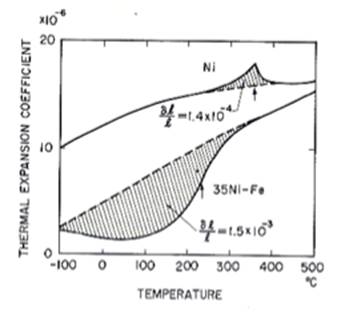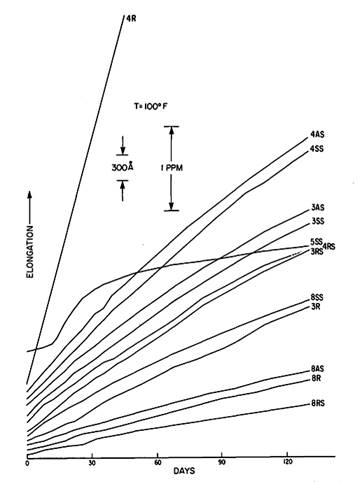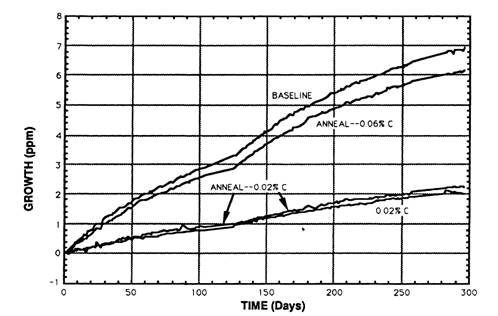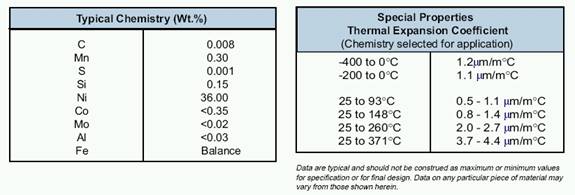An Introduction to Invar
By Scott Gibb
Graduate Student
College of Optical Sciences
University of Arizona
Summary
This paper is intended to serve as an introduction to Invar for an audience of opto-mechanical engineers. I wrote this paper as part of a class in opto-mechanical engineering taught by Professor James Burge at the University of Arizona. A major motivation for writing this paper was to educate myself on the physical properties and practical aspects of using Invar and SuperInvar in high precision mechanical systems. This paper should interest those engineers eager to learn the basics of Invar. I do not claim to be an expert in Invar; in fact I’ve only worked with Invar on a few occasions and in writing this paper I read a number of papers on the dimensional stability of Invar and have tried to summarize some of the most important information here.
The Basics – What is Invar?
Invar is a metal used in applications in which a high degree of dimensional stability under changing temperatures is desired. It is used in precision mechanical systems in many different industries and is not limited to opto-mechanical engineering applications. Invar is actually part of a family of low expansion iron-nickel alloys whose most well known members are probably
When someone uses the word Invar they most likely mean Invar 36. This paper focuses mainly on Invar 36 as it is the most common iron-nickel alloy used in opto-mechanical engineering. SuperInvar is also discussed, but less so, and Kovar is only mentioned a few times.
The most valuable property of Invar is its low coefficient of thermal expansion (CTE). At room temperature it is approximately 1ppm/K, however like most mechanical properties, CTE varies with temperature. Invar’s CTE is the lowest of any metal (Ref 4 and 5). CTEs of common materials are shown in Table 1.
Material |
CTE (x 10-6K-1) |
Metals |
|
Aluminum |
23.6 |
Copper |
17.0 |
Gold |
14.2 |
Iron |
11.8 |
Nickel |
13.3 |
Silver |
19.7 |
Tungsten |
4.5 |
1025 Steel |
12.0 |
316 Stainless Steel |
16.0 |
Brass |
20.0 |
Kovar |
5.1 |
Invar |
0.5 to 2.0 |
Super Invar |
0.3 to1.0 |
Ceramics |
|
Fused Silica |
0.4 |
BK7 glass |
7.1 |
Borosilicate glass |
3.3 |
Polymers (Plastics) |
~100-200 |
Table 1. CTEs of selected materials. (Ref 3).
One will note that Invar and SuperInvar’s CTEs are well below the CTEs of the most widely used metals, aluminum and steel.
From an atomic perspective, thermal expansion is reflected by an increase in the average distance between atoms. Greater atomic bonding energy in the material will yield a lower CTE; therefore ceramics with relatively strong interatomic bonding have lower CTEs than polymers and metals. This is reflected in Table 1. The low expansion coefficient of fused silica can be explained by a low atomic packing density such that interatomic expansion produces relatively small macroscopic dimensional changes. For further discussion of thermal expansion at the atomic level refer to Reference 3.
The CTE of Super Invar can have near zero CTE with special heat treatment processing, but this is true over only a very limited temperature range (Ref 9). The slower change of CTE with change in temperature of Invar 36 may make it preferable to Super Invar in some applications involving significant temperature changes.
As will be discussed in more detail, the actual CTE of Invar depends on its temperature, machining history and composition (Ref. 9).
Invar’s low CTE is wonderful for the opto-mechanical engineer who desires to build systems which are invariant to temperature, i.e. systems which must meet certain performance goals through changing temperatures. Since the wavelength of light for optical systems in the visible portion of the spectrum is approximately 0.5μm, and system requirements typically demand that optical elements be held to some tolerance near this value, a structural metal with a low CTE is of extreme value.
Invar was invented by a Swiss named Charles Edouard Guillaume in 1896 in Paris. In his pursuit for a low-expansion metal, Guillaume discovered that the CTE of iron-nickel had an extremely low CTE when its composition consisted of 36% nickel and 64% iron as shown in Figure 1 (Ref 10).

Figure 1. This plot shows the CTE of iron-nickel as a function of nickel composition. One will note that CTE is lowest near 36% nickel. (Ref. 10)
The word Invar is capitalized because it is a trade name of a French company named Imphy Alloys. This company originates from a small city near Nevers, France where the alloy was initially industrialized after its invention. The generic name for Invar® is FeNi36 (Ref. 1).
Most would guess that the name Invar refers to Invar’s invariance to thermal expansion due to changing temperatures. However, Yoder writes that Invar “…has a virtually invariable (hence the name) and low CTE over a limited temperature range (typically 40 to 100 F [4 to 38 C]).” This implies that Invar’s invariance is due to its CTE’s invariance (zero slope) near room temperature. This can be more clearly seen in Figure 2, which shows a plot of Invar’s CTE vs. temperature.

Figure 2. Shows the CTE of Invar (the lower solid curve) vs. temperature. Notice that its CTE is invariant near room temperature and that its CTE stays very low in the -100 to 200 F range. (Ref. 10)
Invar looks and feels similar to steel. This makes sense since Invar is a ferrous alloy – one in which iron is the prime constituent. Ferrous alloys are produced in larger quantities than any other metal type (Ref 3). Remember that steels and cast irons are iron-carbon alloys (0.25% - 6.7% carbon, majority iron) and as already mentioned Invar is an iron-nickel alloy. Invar contains from 0.01 to 0.1% carbon. High purity Invar will contain <0.01% carbon (Ref 12). The carbon content of Invar, along with other “impurities” is a major factor in its temporal stability and will be discussed in more detail later. Besides iron and nickel, Invar 36 may contain nickel, cobalt, chromium, carbon, manganese, phosphorous, silicon, sulphur, aluminum, magnesium, zirconium, and titanium. The exact percentages of these elements in Invar will vary depending on the specification and manufacturer. Super-Invar contains about 5% cobalt in exchange for 5% less nickel.
How do the mechanical properties of Invar 36 compare with those of a common structural metal like 304 stainless steel? Table 2 provides a comparison.
Material |
Units |
Invar 36 |
304 Stainless Steel |
Density |
g/cm3 |
8.05 |
8.00 |
Young’s Modulus |
GPa |
141 |
193 |
Poisson’s Ratio |
- |
0.26 |
0.27 |
Microyield Strength |
MPa |
70 |
>300 |
Thermal Expansion Coefficient |
|
1 |
14.7 |
Thermal Conductivity |
W/m K |
10.4 |
16.2 |
Specific Heat |
W s/kg K |
515 |
500 |
Specific Stiffness |
- |
17.5 |
24.1 |
Thermal Diffusivity |
10-6 m2/s |
2.6 |
4.1 |
Thermal Distortion (Steady State) |
µm/W |
0.10 |
0.91 |
Thermal Distortion (Transient) |
s/m2K |
0.38 |
3.68 |
Table 2. Mechanical Properties of Invar compared to 304 stainless steel (Ref. 4 and 5)
Overall, Invar is very similar to steel in its mechanical properties. One should note a few differences between Invar 36 and 304 stainless steel however. Young’s modulus and specific stiffness are lower for Invar, microyield strength is lower for Invar, and thermal conductivity is lower for Invar.
So far so good right? Invar seems like a wonderful metal for applications requiring high dimensional stability through temperature changes. One should remember however, that dimensional stability refers to how a part made of a given material changes shape due to changes in environmental parameter such as time, stress, and/or temperature variation. In order to use Invar effectively one must be aware of its temporal stability issues as well as its thermal stability properties. Let’s look in more detail at Invar’s thermal stability and then we’ll look at its temporal stability.
As can be seen in the CTE vs. temperature plot already shown, and in Figure 3, Invar’s CTE is only low near room temperature and increases with temperature decreases and increases from its minimum point.

Figure 3. Thermal expansion coefficients of Invar and SuperInvar vs. temperature. One will note that the CTE of SuperInvar closely matches that of ULE and Zerodur, and the CTE of Invar closely matches that of fused silica. (Ref. 2)
The point here is that CTE is a function of temperature, i.e., CTE(T). When doing thermal expansion analysis for mechanical systems one should remember that the change in length of a mechanical part is given by
![]() (1)
(1)
For most calculations CTE(T) can be taken as a constant, but remember to use the average CTE over your temperature range. For Invar 36, CTE varies from -0.6 to 3.0 ppm/K between -70 to 100 C and can be limited to 0.8 to 1.6 between 30 and 100 C by careful control of material during processing (Ref 13). It is not often that one has to use the more general formula given by
 (2)
(2)
Eq. 1 is used almost exclusively because variations in CTE are small for most (small) temperature variations. For larger temperature variations, in regions of high ![]() , Eq. 2 may be preferred.
, Eq. 2 may be preferred.
Besides the variation in CTE vs. temperature shown in Figure 3, one should note that the CTE of Invar matches that of fused silica closely, and the CTE of SuperInvar matches that of ULE and Zerodur. Though not shown, the CTE of Kovar matches that of borosilicate (Pyrex) glass fairly closely. Kovar was designed to match the CTE of borosilicate (Ref 3).
Now let’s talk about the temporal stability of Invar. Invar expands with age, even at constant temperature! Its growth over time depends on many factors, the most important are: time since final machining, carbon content, heat treatment, and ambient temperature (Ref 15). Figure 4 shows various samples of Invar expanding over time. These samples differ in lot (composition, batch, and manufacturer) and heat treatment.

Figure 4. This plot shows the growth of various samples of Invar (of varying lots and heat treatments) over a 120 day period held at 38 C (100 F). (Ref. 2)
Many studies have been conducted on the temporal stability of Invar (Refs 2, 11, 12 and 15 to mention a few). These can be somewhat involved and confusing to read (maybe because the compositions of the Invars used vary between experiments). For next generation systems such as built by JPL in 1993, these studies yielded great success. JPL obtained possibly the most dimensionally stable (lowest CTE, plus lowest temporal change) Invar 36 ever produced (Ref 12). The CTE of this material was 1ppm/K and its temporal stability was 1ppm/year. This Invar was used for the metering rods in the Cassini imaging system. A major theme in the JPL/Cassini paper and throughout the literature is that greater carbon content and other impurities in Invar lead to greater temporal growth. Carbon is the most critical impurity however. As shown in Figure 5, the growth of the 0.02% carbon content sample was less than that for the 0.06% carbon content sample by 4 ppm over 300 days.

Figure 5. Growth of Invar samples as a function of time. The 0.02% carbon content sample had lower growth (greater temporal stability) than the 0.06% sample. (Ref. 15)
The dimensional stability of Invar can be less than 1-2 ppm/yr. This requires very low carbon content, <0.02% and is aided by low magnesium and silicon (Ref 4 and 5).
Also of great importance is the heat treatment of Invar. The heat treatment reduces the temporal growth of the Invar by effectively aging it. Invar’s temporal growth does not continue on forever at high rates; it tapers off with time and the heat treatment causes the Invar to age prematurely, thus decreasing its temporal growth. The details of heat treating are discussed in more detail later.
It is interesting to note in the JPL/Cassini mission that SuperInvar, even though it has a lower CTE at room temperature and has been shown to have a lower temporal growth in some cases (see Figure 6), was eliminated as a possible material for the metering rods because of its highly composition-dependent irreversible phase transformation (Ref 12). What does this mean? SuperInvar undergoes a phase change at low temperatures, which permanently destroys its low CTE properties. The temperature at which this occurs is highly composition dependent. Further, SuperInvar has a highly temperature-dependent temporal stability and may be difficult to fabricate (Ref. 12). In general, SuperInvar is less common in opto-mechanical engineering than Invar 36.

Figure 6. This plot (from Ref. 15) shows that SuperInvar can have greater temporal stability than Invar 36.
Practical Topics
This section discusses a number of practical topics important to an opto-mechanical engineer who needs to create drawings and build hardware using Invar.
How much does Invar 36 cost relative to 304 stainless steel? About five times as much according to one quote obtained by the author from a major Invar vendor (Ref 8). A 100lb, 1 inch round of 304 stainless steel runs $4 per pound, whereas a 100lb, 1 inch round of Invar 36 runs $19 per pound.
Various applications of Invar in opto-mechanical engineering are highlighted by Yoder (Ref. 9) and on the Carpenter Corporation website (Ref 8). Some typical applications include lens and mirrors cells, interfacing spacers between optics and other structures, metering rods for telescopes and laser cavity structures.
Being tough and ductile, Invar is somewhat difficult to machine. Most machinists would agree that Invar is more difficult to machine than steel. Some smaller machine shops may even shy away from certain Invar jobs if the parts are too complex, tightly toleranced or require large amounts of material removal. When machining Invar, cutting tools will wear relatively quickly and cutting speeds will be slow. Thus machining Invar requires more patience on the part of the machinist, longer lead-time, and greater cost for the engineer procuring the part.
Unlike engineering drawings for aluminum and steel parts, Invar part drawings usually contain a detailed machining/heat treatment procedure. The purpose of this procedure is to obtain an optimal coefficient of thermal expansion and temporal stability. This machining procedure usually incorporates the “MIT” or “Lement” heat treatment (Ref 13). A simple drawing using this heat treatment would specify the following:
The above procedure is relatively simple and inexpensive; however, there is a problem with it: Vukobratovich states that heavy machining, i.e. greater than 100μm cuts, may disturb the heat treatment of Invar and necessitate another heat treatment cycle (Ref. 13). An alternative procedure to the one above (used for high precision Invar parts) would involve rough machining close to final dimension (~0.05in), then a heat treatment (not necessarily the one above), semi-finish machining (~0.005in), then another heat treatment (different than the first) and then final machine. These procedures may be proprietary at some companies and usually vary from part to part depending on the level of precision desired.
Other instructions on the engineering drawing may specify that the material not exceed a certain temperature and to not magnetically chuck the part during machining. Since Invar is vulnerable to corrosion it is sometimes plated with nickel or chromium. Also, engineers and technicians should be aware that a stainless steel screw inserted into a tapped Invar hole may gall.
Like aluminum and steel part drawing, a material specification is usually specified on the drawing. There are various compositions and specifications to choose from and the final determination will depend on the application. One Invar material specification which the author has seen used for a mirror cell is AMS-I-23011, Class 7, annealed. Another specification is ASTM F1684 (UNS K93603). I’m not familiar with the details of these, however some internet research would likely yield some answers.
The engineering drawing does not usually specify a particular Invar vendor for the machinist to procure from, but rather imposes a specification. However, by looking over the spec. sheets of Invar manufacturers one may determine an appropriate specification to place on the engineering drawing. One manufacturer of Invar 36 is Carpenter Corporation (Ref. 8). Spec. sheets are available at their website. Their Invar 36 composition is 0.02% carbon, 0.20% silicon, 0.35% manganese and 36% nickel. This material meets specification ASTM F1684 (UNS K93603). CTE vs. temperature plots are provided along with instructions for heat treating and annealing.
As shown in Figure 7, Carpenter also sells SuperInvar. These Figures are excerpts from their SuperInvar 32-5 spec. sheet showing a general description of their SuperInvar and its composition.


Figure 7. Composition of Carpenter’s Super Invar 32-5.
Besides providing excellent specification sheets for their Invar alloys, Carpenter also has some excellent technical articles on Invar. Their titles include (Ref. 8)
Unfortunately I discovered these late in writing this document and did not incorporate them. It seems there is a wealth of information in them however.
Another manufacturer of Invar 36 is Allegheny Ludlum (Ref 14). This vendor manufactures AL 36, which is a nickel-iron alloy, the composition of which is given on the spec. sheet at their website and partially reproduced in Figure 8. This material meets specification ASTM F1684 (UNS K93603) as well.

Figure. 8 Composition and CTE as a function of temperature for iron-nickel alloy AL 36 manufactured by Allegheny Ludlum.
A third vendor of Invar is National Electronic Alloys Inc. Their Invar 36 composition is different from the above two vendors. There are other vendors as well.
Acknowledgements
I’d like to thank Charles Burkhart of the College of Optical Sciences for providing me with information on the machining of Invar and I’d like to thank Mark Sullivan of Lockheed-Martin, Palo Alto for providing me an array of information on Invar including vendors, specifications, and his engineering experiences in working with Invar. Also, while presenting this paper to my opto-mechanical engineering class at the College of Optical Sciences, two students asked questions which I did not have good answers for. These questions were
I haven’t found the energy yet to research these questions yet, but if someone reading this has some information on these questions feel free to email me at sgibb@optics.arizona.edu and I’ll update this paper.
References
Source: https://www.ariel.ac.il/sites/conf/mmt/mmt-2008/Service_files/papers/Session_1/1_80-89.doc
Web site to visit: https://www.ariel.ac.il/
Author of the text: indicated on the source document of the above text
If you are the author of the text above and you not agree to share your knowledge for teaching, research, scholarship (for fair use as indicated in the United States copyrigh low) please send us an e-mail and we will remove your text quickly. Fair use is a limitation and exception to the exclusive right granted by copyright law to the author of a creative work. In United States copyright law, fair use is a doctrine that permits limited use of copyrighted material without acquiring permission from the rights holders. Examples of fair use include commentary, search engines, criticism, news reporting, research, teaching, library archiving and scholarship. It provides for the legal, unlicensed citation or incorporation of copyrighted material in another author's work under a four-factor balancing test. (source: http://en.wikipedia.org/wiki/Fair_use)
The information of medicine and health contained in the site are of a general nature and purpose which is purely informative and for this reason may not replace in any case, the council of a doctor or a qualified entity legally to the profession.
The texts are the property of their respective authors and we thank them for giving us the opportunity to share for free to students, teachers and users of the Web their texts will used only for illustrative educational and scientific purposes only.
All the information in our site are given for nonprofit educational purposes